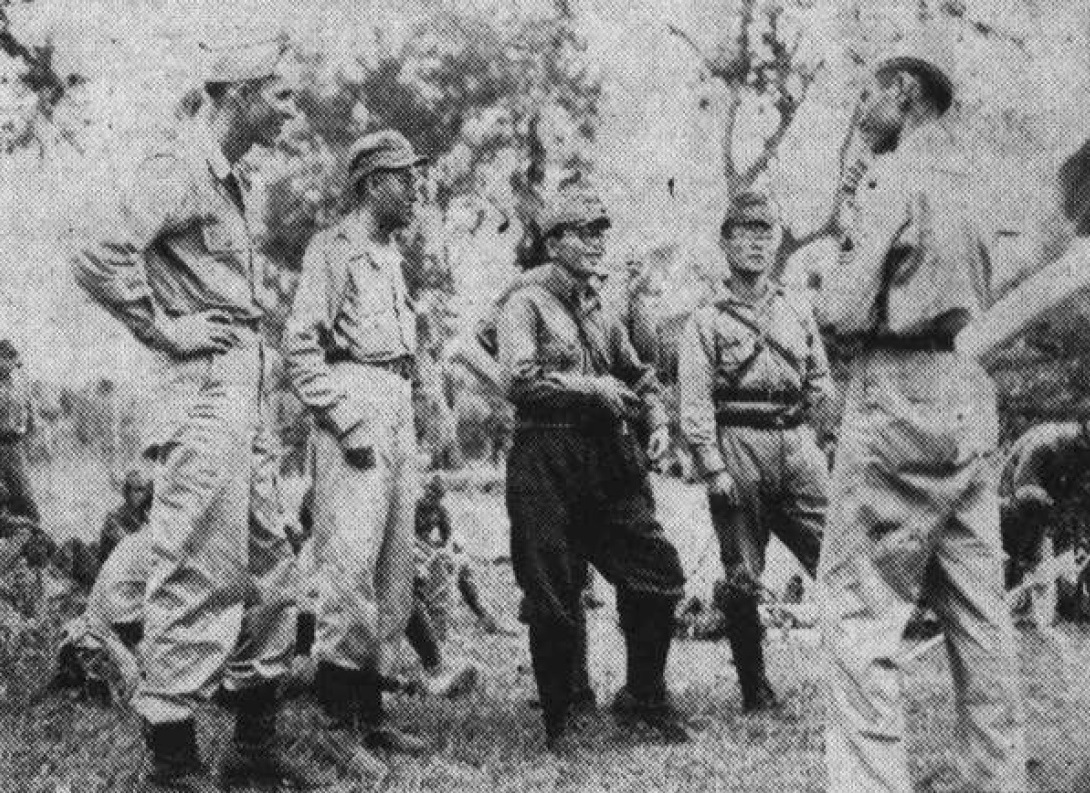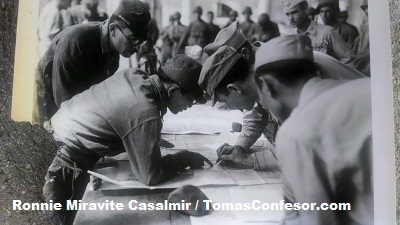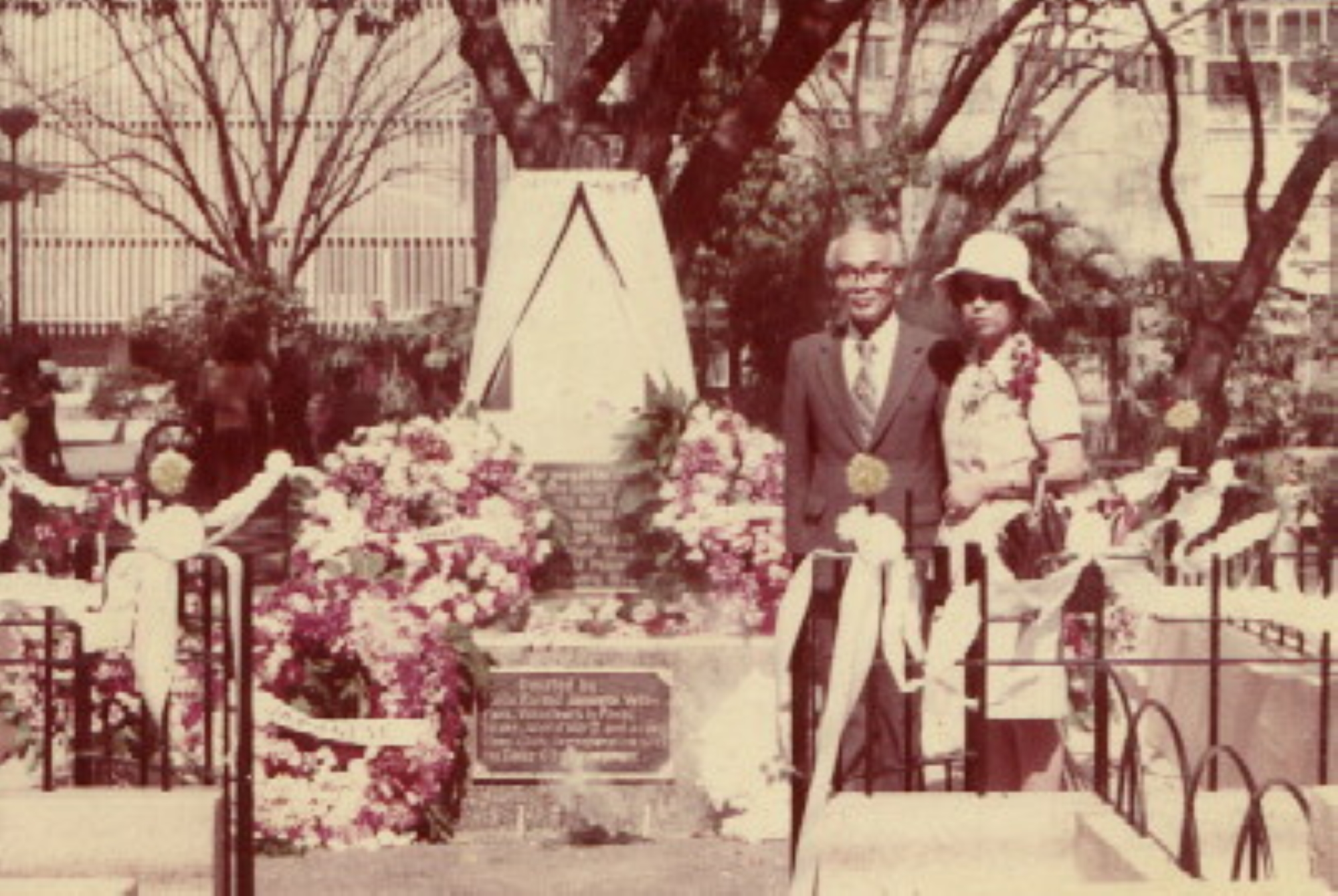SADAYOSHI ISHIKAWA
Lieut. Sadayoshi Ishikawa, middle, with, from left to right, Lieut. Larson, Lieut. Jacobs, Capt. Kaneyuki Koike and T-Sgt. Terno Odow, during the surrender negotiations on August 28, 1945 in Maasin, Iloilo. In the background are Japanese soldiers who acted as guards for the Japanese surrender negotiation delegation.
This photo came together with the other Iloilo surrender photos. The scene matches a description of Eliseo D. Rio that during the surrender negotiations on August 28, 1945 in Maasin, Iloilo, at the Maasin churchyard, the Americans and Japanese pointed at their maps the location of their agreed meeting place. Lieut. Lieut. Sadayoshi Ishikawa appears to be second from left. The Japanese-American translator Tech. Sgt. Terno Odow appears to be at far right, in the foreground.
Note: The Japanese surrender negotiation delegation sent to Maasin, Iloilo on August 28, 1945 was composed of Captain Koike, 1st Lieutenant Ishikawa and Lieutenant Kumai, with Sergeant Matsuzaki as the interpreter. The NCO cadet platoon that accompanied them as escort was led by 1st Lieutenant Horimoto, with Private First Class Ueki as the interpreter.
Date of Birth: 25 October 1917
Registered Domicile: Ehime-ken; Nii Gun; Izumigawa cho; 1453
20 March 1935 - Graduated the Saijijo Agricultural School - Eaime ken.
20 March 1939 - Graduated the Osaka Youth School Teachers College.
31 March 1939 - Appointed instructor at Osaka Sinomiga Youth School.
10 February 1940 - Inducted into 22nd Infantry Regiment through special call in General Mobilization program.
1 August 1940 - Appointed an officer candidate.
1 December 1940 - Entered Kumamoto Military School.
30 July 1941 - Graduated from Kumamoto Military School and appointed as a probational officer - duty with 122nd Infantry Regiment.
1 November 1940 - Appointed 2d. Lt. - duty with 142nd Infantry Regiment.
October 1942 - Landed in Panay
15 September 1943 - Promoted to 1st. Lt. - duty with 37th Independent Battalion.
1 January 1944 - Transferred to 170th Independent Battalion as S-2, S-3.
20 August 1945 - Promoted to Captain.
28 August 1945 - Bearer of the flag of truce at Maasin, Panay.
1 September 1945 - Surrender at CABATUAN, PANAY.
19 March 1946 - Returned to Japan from Takuroban, Leyte. Debarked at Uraga.
1 April to September 1946 - Taught at Osaka Sinomeija Youth School.
Since September 1946 - Engaged in farming.
This was a photo of Ishikawa and his wife attending the inauguration of the war memorial built by former Japanese residents and veterans (led by the daughter of principal, Junko Kayamori Tanaka, and Toshimi Kumai with the help of local 2nd generation descendants led by Arturo Sabido (Suehiro).
This was Feb 14, 1976, in what is now part of Sunburst Park. It was taken down when the Freedom Grandstand was expanded in front to the Aduana/Customs House.
Photo and caption by Ma. Luisa E. Mabunay

Mentions of Lieut. Ishikawa in The Blood and Mud in the Philippines of Lieut. Kumai:
Section 7.3 Since we were led to believe that the battle in Leyte was still going on, no preparations had yet been made in Panay. Guerrillas had completely cordoned off Iloilo City and any urgent troop movement was impossible. Toward dusk that day, information about the fleet movement stopped coming in. Colonel Tozuka, 1st Lieutenant Ishikawa and I consulted and concluded that we should fight to the last man. Forces inside the city were ordered to get prepared. We could do nothing with only 2,000 aerial bombs. We all waited without sleep.
Section 7.4 Prior to the US landing on Panay, Colonel Tozuka, 1st Lieutenant Ishikawa and I had reexamined our plans and agreed on the following policy. The Japanese forces in Iloilo City should all dash through the guerrilla siege lines and go to the village of Bocari in Leon – situated south of Mt. Inaman, in the mountainous region in the west-central part of Panay Island – where they could continue fighting for as long as possible. Bocari, where Governor Confesor used to have his base, was an excellent haven in terms of both geographical strategy and food supply. The problem was distance. It was 22 kilometers on a straight line from Iloilo City to the town of Alimodian at the foot of Bocari. The difficulty lay in how to break through the siege lines of the US and Filipino armies.
Section 7.4 In mid-February 1945, staff officer Colonel Watanabe came to Iloilo City. Showing a map, he informed us of the order given by Brigade Commander Kono: ‘Based on American operations thus far, we estimate the US landings on Panay and Negros by around the middle of March. Upon the landing of US forces on Panay, proceed to the plateau 10 kilometers west of Alimodian, set the position there to fight against them.’ Ishikawa and I immediately disagreed with the plan; the plateau would be an easy target of the tanks and artillery guns. Critical and oblivious to our opinions, Lieutenant Colonel Watanabe repeated the order, saying, ‘All you think of is just how to flee.’ I was silent, quietly considering that once the US forces had landed, it would be impossible to get relief from brigade headquarters in Bacolod City. Therefore, it was unimportant whether we obeyed their order.
Section 8.1 Around 2 p.m., we suddenly heard guns in the direction of Molo – a dozen shots that moved from point to point, which made me wonder if the guerrillas had finally started using self-propelled guns. Running and stumbling like a rolling ball, an orderly from the Fujii unit soon arrived to report, ‘The enemy tanks are attacking the Molo position.’ The second orderly followed with the report, ‘A dozen enemy tanks are approaching and fiercely attacking from the direction of Molo. There are three or four tanks at the Molo Bridge. The landmines all ended up misfiring. Hurry up and send reinforcements!’ Damn, all my reliable landmines had misfired. I stomped my feet in frustration. Now there was no doubt about the landing of the US forces. First Lieutenant Ishikawa immediately sent the Machine-Gun Force and NCO Cadet Platoon to reinforce the Molo position.
Section 8.2 At the meeting, the headquarters staff all looked tense. Apart from Lieutenant Colonel Ryoichi Tozuka (unit commander). 1st Lieutenant Ishikawa, and myself, there were the following: Army Doctor Egami, Finance Officer 1st Lieutenant Kuge, 1st Lieutenant Yamamoto (deputy commander of the machine-gun force), Lieutenant Fujii of the 2nd Company, Captain Kaneyuki Koike (Kempeitai commander), and Lieutenant Noda of the 1st Company of the Tanabe unit, Commander Suzuki of the Transport Company, and 1st Lieutenant Mizutani (commander of the oil tank construction unit), a captain in charge of engineering of the airfield construction unit, Commander Ika of the Hôjin Company, 1st Lieutenant Nakamura of the remaining 102nd Division forces, President Kimura of the Japanese Association (Nihonjin-kai), and Medical Doctor Tanaka of the Iloilo Army Hospital. With a few dozen men, Captain Torao Saitô (machine gun unit commander) had left the previous night to lead the retreat of the Santo Rosario garrison at Guimaras. They managed to get back later that evening.
Section 8.2 Colonel Tozuka ordered the abandonment of Iloilo City and the move towards Bocari. I then explained the plan. The plan of the operation was to break through enemy positions at Jaro by force. The front right line, under the command of Captain Torao Saitô, consisted of around 450 men of the machine-gun force, the NCO cadet force, the transport company, the labor platoon attached to the headquarters, and the communication unit. There were around 200 men from the Noda Company of the Tanabe unit and a mortar platoon at the front left line. With the road between Jaro and Pavia at the center, the Saitô Force on the right, the Noda Force on the left, the course of the attack was all left with Captain Saitô, with lst Lieutenant Ishikawa as adviser.
Section 9.1 We had withheld the use of heavy machine guns and mortars. However, since there was abundant game before us, it was silly not to take action. What is more, it was not good for our morale. Upon discussion, Colonel Tozuka, 1st Lieutenant Ishikawa and I decided to try shooting into the enemy with heavy machine guns and mortars.
Section 10.1 That day, the unit commanders’ meeting decided that, as previously planned, the Japanese Army emissaries would be Captain Koike of the Kempeitai, 1st Lieutenant Ishikawa and I, with Sergeant Matsuzaki as the interpreter. The NCO cadet platoon led by 1st Lieutenant Horimoto, with Private First Class Ueki as the interpreter, would accompany us as our escort.
Section 10.1 Early in the morning of August 30, the emissaries of the Japanese Army in Panay, Captain Koike, 1st Lieutenant Ishikawa and I, climbed down from Bocari and walked towards the town of Maasin. Moving in front, Private First Class Ueki carried a big white flag. As we advanced, the observation plane came to meet us. Sergeant Matsuzaki kept in touch using the walkie-talkie.
Section 10.1 Our escorting NCO platoon stood by while the four of us – Captain Koike, 1st Lieutenant Ishikawa, I, and the interpreter Sergeant Matsuzaki – were placed on jeeps. I rode with a battalion commander with a platoon of US soldiers guarding our front and back.



